Unlocking Your Glow: A Guide to Amber Skin Tone Colors

Key Takeaways
- Amber skin has warm undertones and a golden or peachy glow with tones from light tan to a deep caramel. It shines particularly bright in natural sunlight and is incredibly versatile to many makeup, hair and clothing colors.
- Undertone is consistent whereas overtone can shift with sun, seasons, or skincare. If you use the vein test and gold jewelry check to verify a warm undertone, you will notice a golden/peachy cast that travels across face and body.
- Genetics and environment sculpt your glow via melanin levels and light reflection. Shield skin with daily broad-spectrum sunscreen, and treat hyperpigmentation with gentle care to keep radiance potent.
- Amber skin is all over the place, it's not uncommon or confined to any particular ethnicity. It's not orange or yellow—it's the perfect balance of warmth that reads as golden, peachy or honey tones.
- Build a simple routine to enhance radiance: gentle cleanse, daily moisturize, SPF every morning, and mild exfoliation a few times a week. Opt for golden or peach based makeup, warm eyeshadows, peachy blush and warm reds or coral lips.
- Style your warmth with earthy tones and bold reds and steer away from frosty colors that subdue shine. Maintain your own checklist of characteristics and test colors in natural light in order to refine your best matches.
🎨 Discover Your Color Palette
Want to find the perfect colors that complement your amber skin tone? Discover your personalized color palette and learn which shades will make your natural warmth shine brightest.
Find My Color Palette →Amber skin color contains warm, golden-brown undertones that can reveal traces of gold, honey or bronze when exposed to natural light. We're all used to seeing it across different geographic areas, influenced by sun and melanin content.
To identify, observe warm undertones that complement natural hues such as olive, rust, and deep teal. Skincare is usually all about sun care and even tone.
Warm neutrals and soft golds are great for makeup. The following sections provide straightforward, actionable advice.
📚 Recent Articles
What is amber skin color?
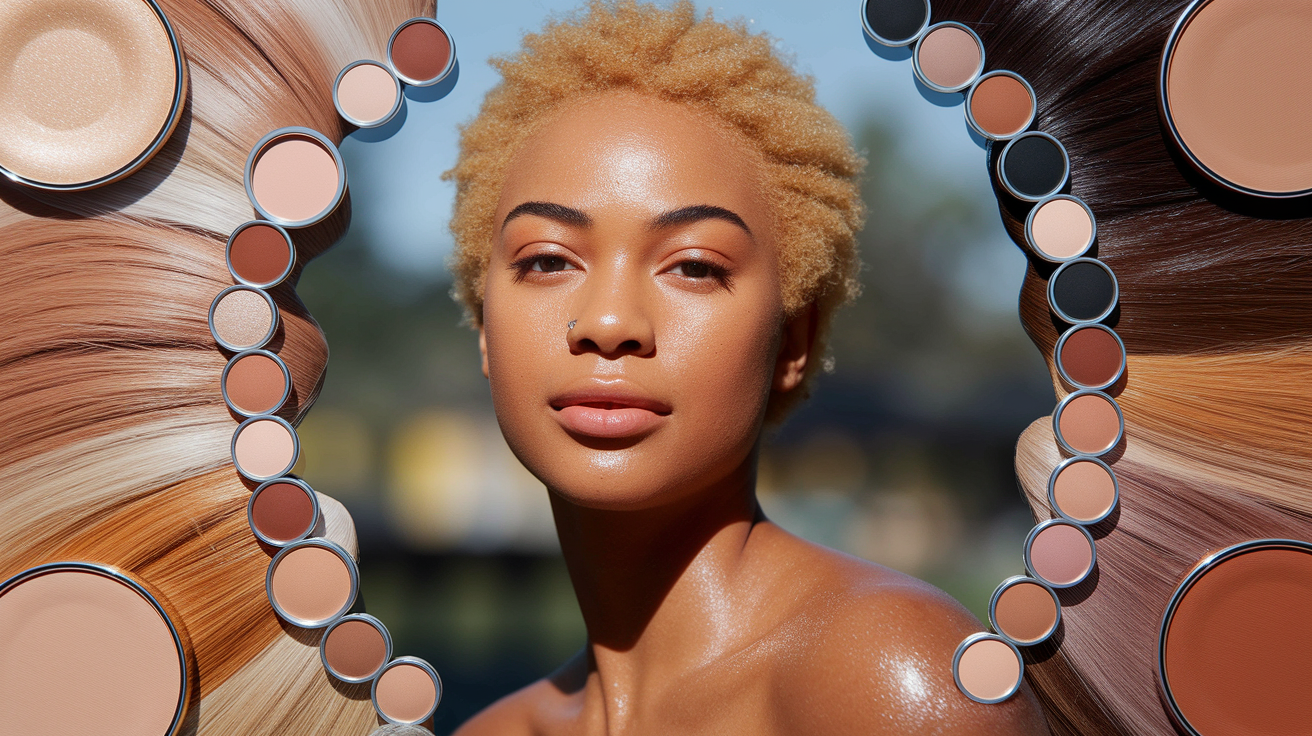
Amber skin color is a warm-based, glowing, sun-kissed complexion. It rests on a golden-to-peach spectrum, rather than neutral or cool, and tends to glow in sunlight. It spans light tan to deep caramel, takes to makeup and wardrobe transitions with ease, and is often associated with Autumn color season palettes.
1. The undertone
Warm undertones appear as a golden, yellow or peach base under the surface color. They provide amber skin its consistent shine and warm feeling that radiates the most in organic light.
A quick check helps: greenish veins at the wrist and a clear harmony with gold jewelry point to warm undertones. Silver can go as well, but gold is more flattering. This warmth amplifies brilliance outside, where amber skin glows rather than blushed.
Undertones remain constant even as your overtone deepens with sun or lightens in winter—tan lines shift, but your base tone does not. Since amber skin skews warm, it complements earthy hues and golden locks such as amber brown.
2. The overtone
The overtone is the surface color you see escaping your notice. Amber skin can be anywhere from creamy ivory with a warm cast, to honey or light tan, to deeper caramel.
Seasonal shifts, skincare actives and a little sun exposure can nudge it lighter or darker. The warm undertone is there, even as the surface shade shifts, which is why those same warm palettes continue working year after year.
If you're constructing a comparison table, have columns for overtone (ivory, honey, tan, caramel), undertone (warm) and nearby categories (neutral beige, cool rose) to illustrate where amber is.
3. The comparison
Amber, in comparison with neutral skin, reads distinctly warm rather than balanced. It exhibits golden or peach undertones, whereas neutral remains flat beneath numerous shades without tipping pink or yellow.
Alongside cool tones, amber appears more sunlit. Cool skin frequently has pink or blue undertones and can appear lighter in white light but less golden in the sunlight.
Common matches for amber skin are brown or amber hair, hazel or warm brown eyes and deep gold-brown brows. Amber skin, in daylight, looks sunnier and more dimensional, and cool skin cleaner and crisper under cooler lights.
4. The identification
Use two quick tests: vein color (greenish) and jewelry (gold flatters more than silver). Then look for consistency in the golden/peachy glow over your face, neck and arms.
Typical indicators are sun-kissed glow, effortless tanning and a balance with nature/earthy and golden-hued clothing. Note health needs too: amber skin is prone to oxidative stress and hormonal shifts.
Daily SPF, antioxidant-rich skincare, and a diet with cruciferous vegetables (broccoli, kale) can help. Reduce toxins and too much sun, seek vitamin C, E, niacinamide and mild retinoids.
The science of your glow
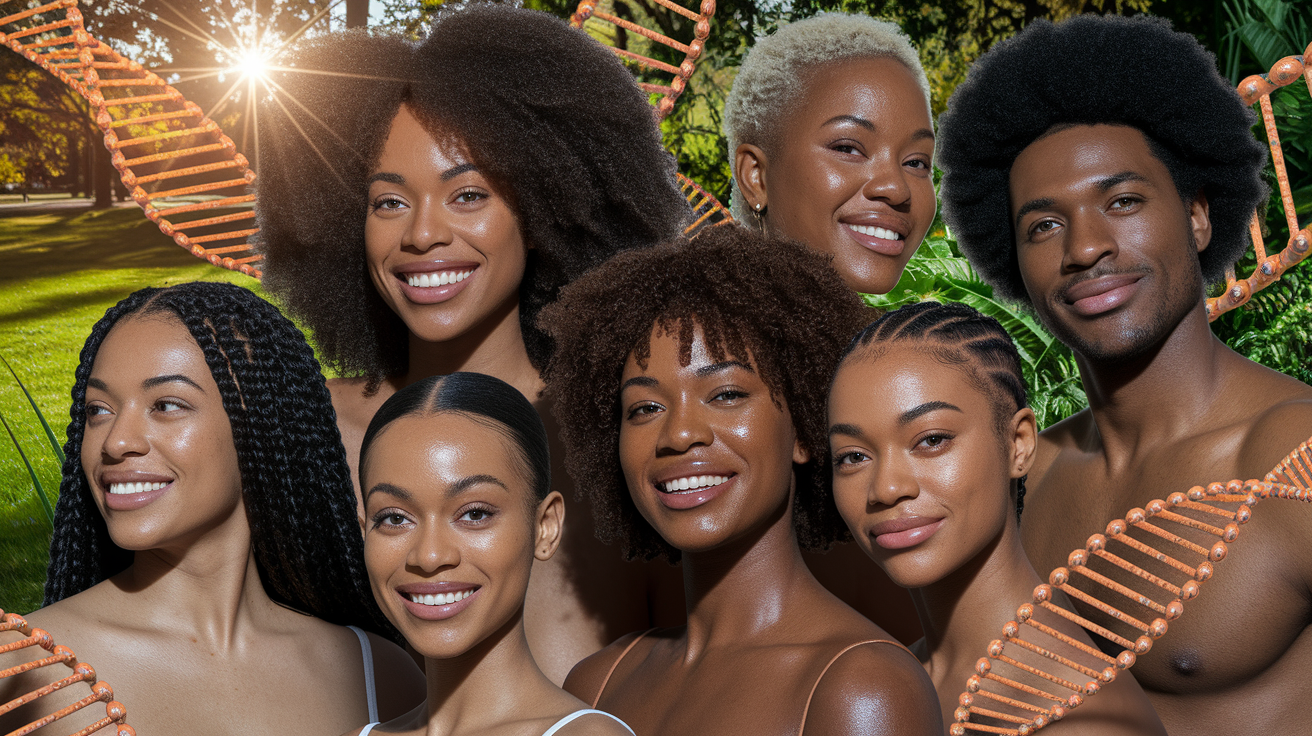
Amber skin type showcases how melanin load and pigment dispersion sculpt light on the face. With more eumelanin and a dash of pheomelanin, warm skin undertones reflect light as a gentle gold rather than a harsh gleam. While dense pigment can block some UV rays, sunscreen remains essential. Genetics influence your underlying skin tone, while sun exposure and treatment can adjust its intensity.
Genetic factors
Amber skin is often inherited from families whom genes push melanocytes to produce consistent melanin, and direct undertones towards warm yellow–gold. Put simply, it's about how much pigment you produce and where it rests. The outcome can appear honeyed in winter and deeper caramel in summer.
Some groups, tracing roots to equatorial or near‑equatorial regions, are more likely to show amber hues: parts of North and East Africa, the Middle East, South Asia, Southeast Asia, and Latin America. Geography molded gene pools that optimize UV wrangling and heat equilibrium.
Genes connect skin with hair and eyes, too. Warm brown or hazel eyes and dark hair with red‑gold hints frequently accompany amber skin, although green eyes or soft black hair can appear as well.
| Trait | Typical pattern in amber skin |
|---|---|
| MC1R variants | Subtle red‑gold undertone without true redness |
| TYR/TYRPs activity | Moderate to high eumelanin output |
| OCA2/HERC2 | Brown to hazel eye range, frequent golden flecks |
| ASIP/SLC24A5 | Warm bias in undertone, even tone across areas |
Environmental effects
Normal sun can enhance amber into a deeper more golden appearance. Brief, mindful time outside can even tone and help the glow look more uniform.
Too much uv still damages. Hyperpigmentation, dark spots and early lines can creep in, particularly on the cheeks and forehead. Broad‑spectrum SPF 30+ protects from UVA and UVB, preserving brightness and an even tone. Apply again outdoors every 2 hours, and compliment with hats and shade.
Climate and habits sign. Dry air kills the glow. Humid air increases surface shine but not hydration. Non‑cross‑linked hyaluronic acid (high molecular weight), used in Amber Glow formulas, pulls and retains water on the skin's surface for soothing, extended hydration.
Succinic acid in Amber Glow assists with mild congestion and supports a smooth, lit finish without harshness. Amber light therapy occupies the 570–620 nm range, typically around 590 nm. It zones in on delicate skin layers, soothing sensitivity and inflammation while coaxing a more even hue.
Photobiomodulation at these wavelengths has been researched for aging, melasma, and facial rejuvenation, with studies published in journals such as BMJ Open. This anti‑inflammatory effect can assist amber skin maintain its clear, steady glow.
Amber Glow (#FFBF00; 100% red, 74.9% green, 0% blue) also has a mood cue—optimism, warmth and approachability—which is why gold lighting flatters ambers in photos and interiors.
Amber skin in culture
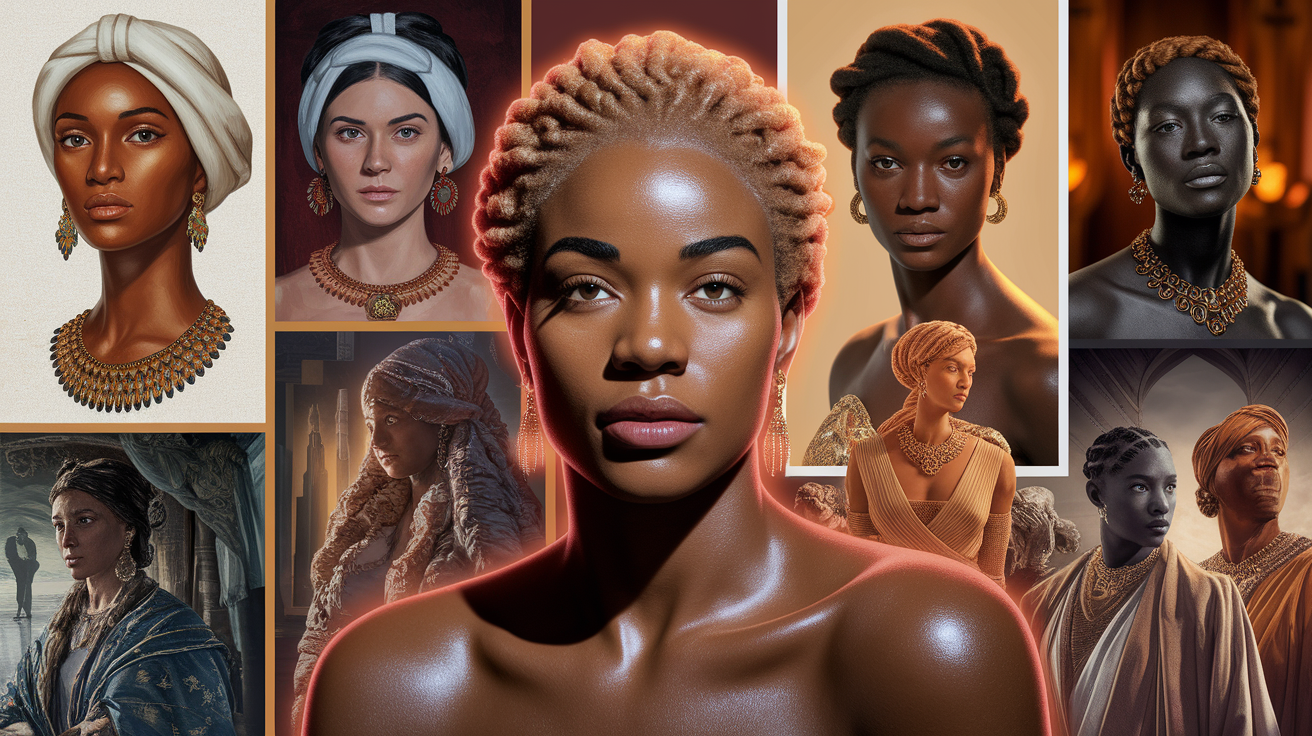
Amber skin, often seen in those with amber hair color, resides between golden beige and light brown, exuding a glowing, sun-kissed, and radiant look. This skin tone has historically denoted attractiveness and well-being, with varying connotations influenced by setting, weather, and authority.
Historical views
The old courts were apt to interpret glowing, amber skins as evidence of virility and good blood. In Mediterranean ports, by contrast, merchants and aristocrats preferred a sun-kissed complexion associated with an active, outdoor lifestyle, a certain cuisine and affluence. In some regions of South and West Asia, poets lionized "honey" or "wheat" skin in their poetry, associating it with fecundity and luminosity.
Yet history is not one note: some societies prized lighter tones as symbols of privilege, so amber shades moved up or down the beauty scale depending on class, work, and rule. Painters hunched over amber skin to outline perfect bodies. Renaissance and Mughal miniatures similarly employed warm ochres to model cheeks and limbs, as those hues imply health in low light.
Sculptors and icon makers stained stone and wood with resins or pigments that simulate amber warmth, producing figures that seemed alive instead of pale or gray. Jewelry spanned the divide between appearance and significance. Real amber—the fossilized resin–was worn as beads, amulets, and brooches from the Baltic to North Africa.
Its honey glow resonated with valued complexions, so jewelry and skin complemented one another, both signified vitality and good fortune. This pairing demonstrates how colour in dress and skin can blend into one style code.
- Cleopatra (as subsequently fantasized in Greco-Roman stories and art) was frequently rendered with a golden olive-amber skin that complimented Nile sunshine and regal glimmer.
- Akbar of the Mughal empire is depicted in miniatures with burnished, amber-brown skin tying rulership to aliveness.
- Venetian courtesans in 16th-century portraits wear ambers as powders and glazes, enhancing a golden skin-illumination coveted by patrons.
- North African Amazigh brides, in folk portrayals, flaunt amber-infused skin against silver and amber beads, denoting health and matrimony.
Modern media
A-listers such as Jessica Alba and Eva Mendes are contributing to normalizing warm, sun-kissed undertones on screens worldwide. Their camera-ready sheen fuels a market for sun-dappled looks sans intense tan, influencing what countless customers interpret as crisp, vibrant, and put together. With the rise of amber skin types, the beauty industry is embracing a wider range of complexions that reflect diverse beauty standards.
Brand campaigns now throw broader shade spectra in print, beauty, and runway. More foundations and concealers match amber undertones — from peach to honey to caramel. When viewers see real matches, it recalibrates the baseline of "neutral," which has historically tilted cool or pale, especially for those with darker skin tones.
Social media accelerates this shift. Makeup artists publish undertone tests under daylight, sharing steps that skip gray cast. We trade in routines for SPF, vitamin C, and sheer tints that let amber warmth shine through. This crowd wisdom confronts limited standards and sails prejudice when editing wipes out depth, particularly for those with amber brown hair.
Color analysts and image pros inform clients about undertone, chroma, and contrast, and use neutral light and shade grids to steer choices. Their work intersects with research: skin color varies by genes, hormones, and sun, evolved with UV and vitamin D needs.
Perception is culture-bound as well — in some contexts, amber skin is associated with mixed-race heritage, granting you social caché, while others continue to place whiteness at the core of power. Media vacuums are important—scant representation entrenches stereotypes, but more nuanced depictions expand the definition of beauty.
Debunking common myths
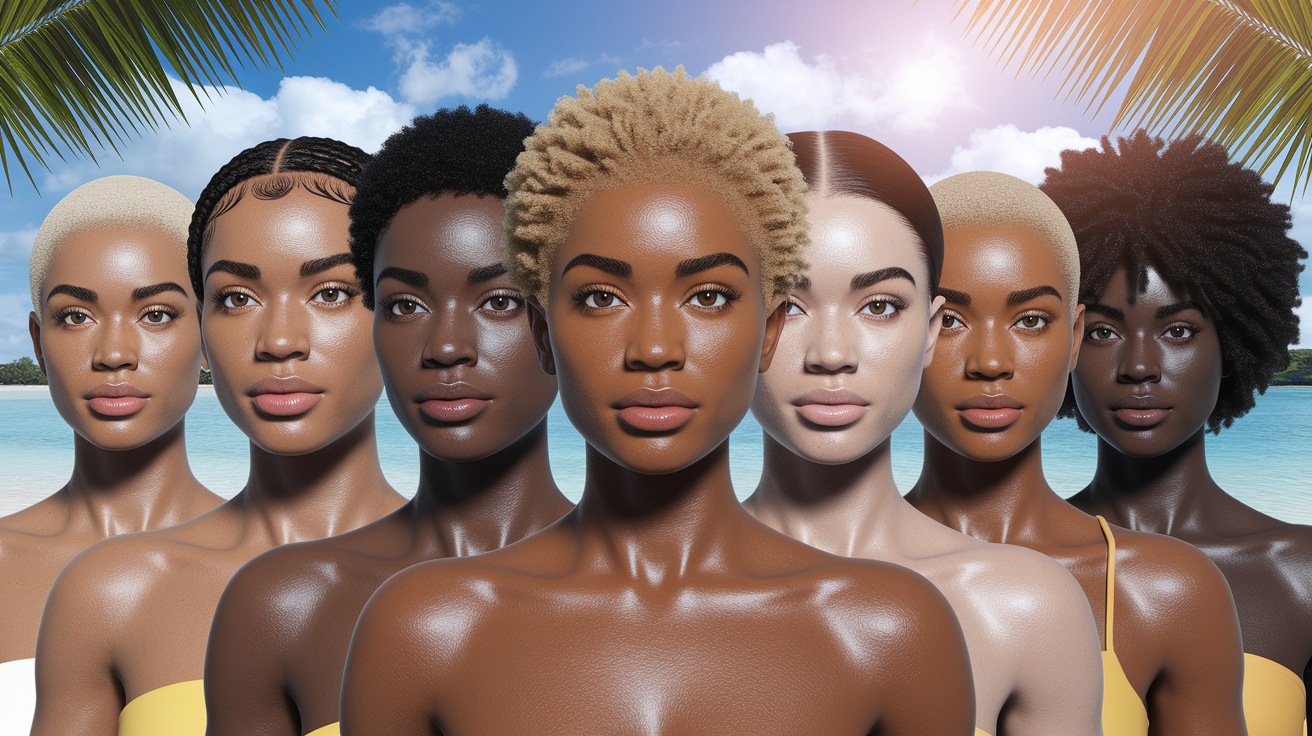
Amber skin type represents a warm-toned spectrum that varies with multiple factors, including weather and maintenance, showcasing different shades across various nationalities.
Dispel the myth that amber skin is rare or only found in specific ethnic groups.
Amber undertones are prevalent in individuals across Africa, the Middle East, South Asia, Southeast Asia, Latin America, and among mixed-heritage populations worldwide. You might observe this in a Nigerian family where the siblings display different shades, from golden-brown to deep bronze, or within a Mexican or Filipino community showcasing warm, sun-kissed hues among cousins. The presence of amber skin types highlights the rich diversity in these regions.
Conversations about rarity often stem from beauty magazines and the limited shade ranges offered at retailers, rather than reflecting real-life diversity. Colorism distorts our discussions about and perceptions of various skin tones. In the African American context, colorism emerged from how lighter skin was valued by white individuals, a prejudice that continues to affect media representation, job opportunities, and overall social standing.
Experts have challenged the notion that victims of colorism are simply "envious" or "unsure"; it's a matter of prejudice, not personal failure. The situation is multifaceted: in certain areas, such as Latinx communities, lighter skin may be favored, while in other contexts, individuals with amber brown hair may be more sought after.
Research indicates that extremely light-skinned African American or Latinx individuals can experience life outcomes similar to those of white populations, underscoring how skin tone remains a significant social barrier across different communities.
Correct misconceptions that amber skin cannot have dark or deep shades; it spans a wide spectrum.
Amber is about warm undertones, not brightness. It can be light honey, mid-tone caramel or deep espresso with a golden cast. A Nairobi cyclist with a deep warm brown tan or a Rio surfer with a rich bronze glow both qualified.
Matching makeup or SPF by "light" or "dark" alone doesn't work. Check undertone with simple cues: gold jewelry flatters, greenish veins, olive-gold cast in daylight. Shade-match on the jaw in natural light, and hang on to two tones for seasonal shifts.
Refute the idea that amber skin is immune to sun damage or pigmentation issues.
Warm undertones still burn and tan. UVA ages skin, UVB burns, both increase risk. Amber skin can get post-inflammatory marks after breakouts, waxing or bug bites.
Apply broad-spectrum SPF 30+, 2 mg/cm2, reapply every 2 hours outside, hats and UPF fabric. For dark spots, go slow and choose evidence-based care: azelaic acid 15–20%, vitamin C (L-ascorbic 10–20%), niacinamide 4–5%, adapalene at night.
Dermatology research highlights that certain popular treatments provide inconsistent, more gradual effects than established methods. Patch test and steer clear of intense peels at home. A cookie-cutter routine can backfire. Skin requirements vary with oil content, environment and delicacy.
Clarify that amber skin is not the same as orange or yellow skin; it features balanced warm undertones.
Orange or sallow casts commonly stem from bad shade matches, indoor lighting, or skin distress, not actual undertone. Amber reads warm but tempered—imagine sunlit resin as opposed to neon marigold.
Try products in daylight, change formulas with seasons, and choose foundations with 'warm' or 'golden' labels that aren't too orange. Beauty value is not connected to tone; that belief is based on traditional standards, not reality.
Enhance your amber skin tone

Amber skin glows when pampered with consistent TLC, spicy hues, and savvy sun sense, particularly with warm hues and tones reminiscent of sunshine and warmth.
Skincare
Daily hydration first. Opt for a lightweight cream in the morning with humectants such as glycerin or hyaluronic acid, then lock in with a mid-weight lotion or face oil at night.
Warm toned skin tends to appear flat when dry, so moisture maintains the radiance. Wash with a gentle, pH-balanced oil-stripping gel or milk. Over-washing causes dullness or tightness, so wash twice a day and rinse with lukewarm water.
Sun is friend and enemy. Apply a broad-spectrum mineral sunscreen (zinc oxide or titanium dioxide), SPF 30+ every morning and reapply if you're outside.
Limit direct sun from 10:00 to 16:00, wear a brimmed hat, and note that UV plus pollution can spark free radicals that age skin and blur warm tones. Exfoliate once or twice a week. A mild acid toner (mandelic or lactic) smooths texture.
Amber powder-infused scrubs can add a soft polish. Amber powder provides antioxidant and antibacterial benefits, which can assist with dullness and mild breakouts. A straightforward 4-step system—cleanse, balance, nourish, protect—keeps things uncomplicated.
Round out care with stress relief (breath-work, yoga, meditation) and a plate with cruciferous greens like broccoli, kale, and turnips to support hormones and skin.
Makeup
Choose foundation with golden/peach undertones; test in daylight along jaw and let settle for 10 minutes to check shift and oxidize. Sheer or skin tints retain the warmth showing.
On eyes, grab copper, bronze, terracotta or warm taupe. A tau brown liner blurs the edge. A swipe of gold in the inner corner lifts the entire visage.
Blush in peach or coral reads most natural on amber skin. Cream textures melt into skin and steer clear of stripes. For your lips, warm reds, apricot, tomato or soft coral look vibrant yet harmonious.
If you want depth, rock brick or rust with a clear balm over it.
Wardrobe
Earth notes flatter fast: olive, rust, mustard, camel, and beige sync with the skin's heat. Bold reds—crimson, brick, cherry—that make amber undertones pop sans harsh contrast.
Forget black and icy blue near the face, they pull warmth. Skip black and graphite in favor of deep espresso, navy with green cast or warm charcoal.
- Neutrals: camel, warm beige, cream, cocoa.
- Greens: olive, moss, sage.
- Reds/Oranges: brick, coral, tomato, rust.
- Yellows: mustard, marigold.
- Blues: teal, petrol, warm navy.
- Accents: gold, bronze, terracotta.
Hair compliments honey blonde, rich brunette or amber brown—each reflects skin warmth and adds gentle luminance around the face.
A personal reflection on amber skin
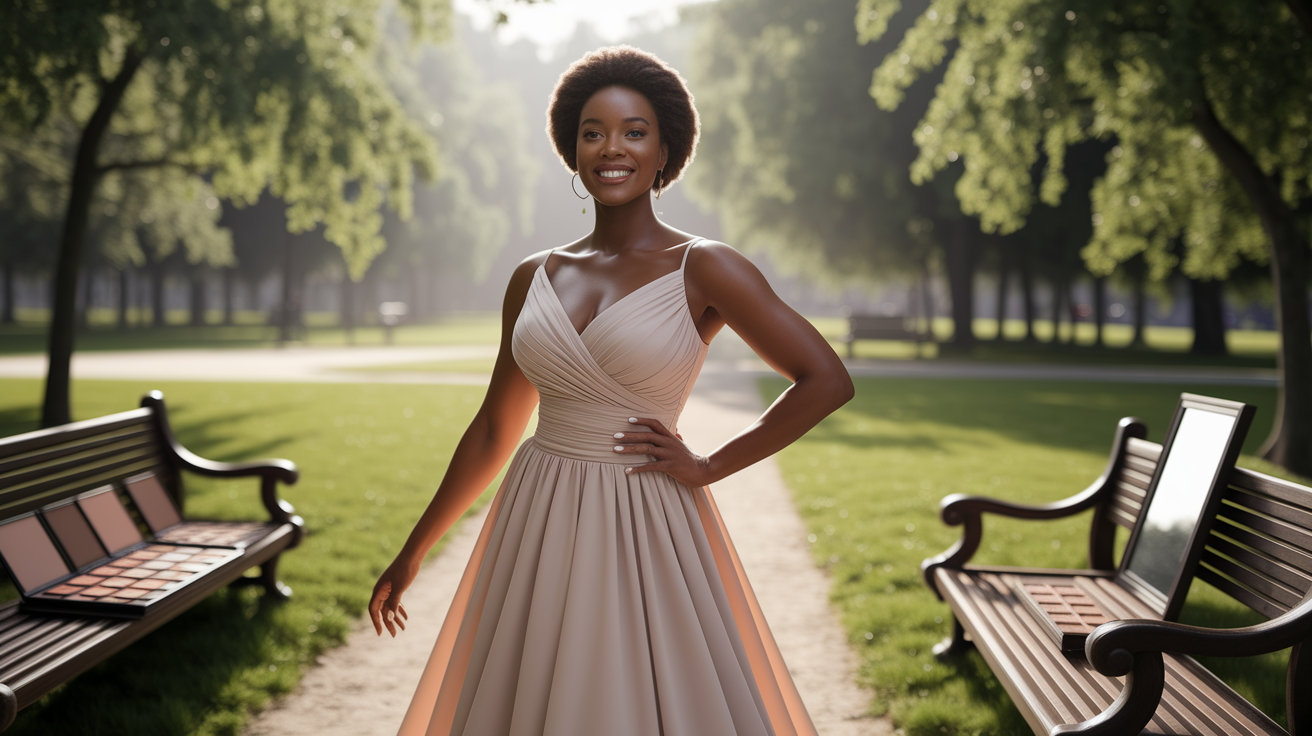
A warm, golden base can seem like a blessing and a conundrum simultaneously. Amber skin types move with light—honey in a shadow, sun‑kissed by a window—and that spectrum can appear radiant with minimal work or patchy if I neglect maintenance. I knew this the hard way – through experiment, failure, and a notebook of patch testing.
Early on, I faced two steady hurdles: shade matching and sensitivity. Foundations tipped too pink or too olive, so my face never quite matched my neck. I cracked it by blending two neutral‑gold tones and trying along the jaw in daylight, not store lights. I now choose labels that read neutral‑warm or golden‑neutral, and hold on to a sheer tint for times when my skin tone swings lighter in winter.
Sensitivity arrived in the form of melasma on my cheeks and forehead. Amber skin can be susceptible to oxidative damage and hormone-driven shifts, so heat, sun, and stress triggered patches. I discovered that oxidative damage occurs when free radicals from UV and toxins exceed the skin's own antioxidants. That framed my schedule and my day.
What works most is a simple four‑step system: cleanse, tone, nourish, protect. I wash with a gentle gel at night to remove city grime, then a creamy milk in the morning so I don't strip away oils. I tone with an alcohol‑free, heat‑soothing formula. I feed with a serum that mixes 10% vitamin C, niacinamide and azelaic acid to assist with tone and texture.
I shield with premium mineral sunscreen, SPF 50, broad-spectrum, daily. I set rules for the sun: seek shade from 10:00 to 16:00, wear a brimmed hat, and reapply. On days I falter it betrays me, the glaze blotchy come evening.
Small lifestyle shifts help the most. Cruciferous vegetables—broccoli, kale, cauliflower—are on my plate to promote hormone balance. Stress care isn't an indulgence, it's maintenance. Ten deep breaths before e‑mail, quick yoga at lunch, and a peaceful five-minute meditation session before bed soothe my amber skin more than any mask.
I even found gentle wins in my kitchen: mashed strawberries as a short mask and almond oil as a light, patch‑test‑first seal on dry spots. Confidence grew when I stopped pursuing one "ideal" shade and began treating my skin like weather to be observed.
Amber skin is flexible; it compliments soft coral, bronze and warm rose. A sheer base, a hint of glow to the high points, and the tone pulls it all together! Embrace the heat, put intelligent boundaries in place, and the shine remains yours.
Conclusion
Amber skin, deep and rich with warm gold notes. Light moves on it in gentle ways. Shade shifts with sun, season and attention. THAT'S the real magic. Science supports the combination of melanin and carotene. Culture injects pride and narrative. Myths melt quickly in the presence of cold hard facts. Good care stays simple: broad SPF 30+, steady moisture, gentle cleanse, and smart shade play. Think peach blush, copper lids, soft brown liner. Gold jewelry adds radiance. Cool silver can pop as well. Choose what resonates with you on your skin.
To maintain the flame, record tiny victories. A sunscreen you adore. A shade for day or night. A habit that adheres. Got a tip or your own story? Post it, query it, thread it.
Frequently Asked Questions
What is amber skin color?
Amber skin color has warm golden-brown undertones. It almost always appears sun-kissed and glowing. It's in the medium-deep range, but with a golden, radiant undertone.
How can I tell if I have amber undertones?
Check your pulse and your bling. If you have greenish veins and look better with gold jewelry, you likely have warm skin undertones. Amber skin types generally tan with ease and never appear ashy.
What ingredients enhance amber skin's glow?
Keep an eye out for vitamin C, niacinamide, and hyaluronic acid for brightness and hydration, especially for those with amber skin types. Apply broad-spectrum SPF 30+ every day. For makeup, warm bronzes, peaches, and terracotta shades flatter neutral skin tones.
Is amber skin the same as olive skin?
Amber skin type features warm golden undertones, while olive skin often has green or neutral skin tones. Both can tan beautifully, but their undertone behavior under makeup and lights differs.
Does amber skin need sunscreen?
Yes. Every skin tone, including those with amber skin type, deserves sunscreen. Use SPF 30+ DAILY to avoid hyperpigmentation, dark spots, and photoaging.
Are there common myths about amber skin?
Yes. Myths are 'it doesn't burn' and 'it doesn't need brightening'. Amber skin type does burn and develop dark spots, so it's essential to use sun protection for a radiant look.
What makeup shades work best for amber skin?
Opt for warm foundations with golden or caramel undertones to complement your skin tone. Bronze, copper, and chocolate eyeshadows pop beautifully, while blush in peach or warm rose enhances your radiant look.